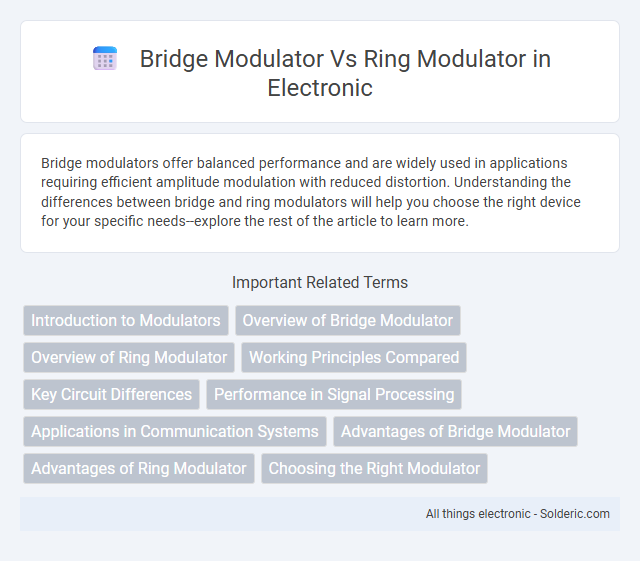Bridge modulators offer balanced performance and are widely used in applications requiring efficient amplitude modulation with reduced distortion. Understanding the differences between bridge and ring modulators will help you choose the right device for your specific needs--explore the rest of the article to learn more.
Comparison Table
| Feature | Bridge Modulator | Ring Modulator |
|---|---|---|
| Modulation Type | Amplitude modulation using bridge circuit | Balanced modulation via ring of diodes or transistors |
| Output Signal | Single sideband or double sideband amplitude modulated signal | Suppressed carrier, generates sum and difference frequencies |
| Carrier Suppression | Partial carrier suppression, depends on balance | High carrier suppression |
| Complexity | Moderate, requires precise component matching | Simple design with fewer components, but precise diode matching needed |
| Applications | Radio transmitters, amplitude modulation systems | Frequency mixing, audio effects, communication systems |
| Linearity | Lower linearity, prone to distortion | Higher linearity, less distortion |
| Frequency Range | Broad frequency range, depends on components | Wide frequency range, suitable for audio and RF |
Introduction to Modulators
Bridge modulators and ring modulators are essential components in signal processing used to combine or mix input signals, particularly in telecommunications and audio applications. Bridge modulators utilize a bridge circuit of diodes or transistors to achieve amplitude modulation and signal inversion, offering improved linearity and reduced distortion. Ring modulators, comprising a ring of diodes, produce double-sideband suppressed-carrier signals, making them ideal for creating complex tones and frequency mixing with efficient carrier suppression.
Overview of Bridge Modulator
A Bridge Modulator is an electronic circuit primarily used for amplitude modulation by mixing two signals while suppressing the carrier frequency. It consists of four diodes arranged in a bridge configuration, enabling efficient modulation with minimal distortion and improved linearity compared to other modulation methods. This modulator is widely applied in communication systems for generating double sideband suppressed carrier (DSB-SC) signals.
Overview of Ring Modulator
A ring modulator is an electronic device that combines two input signals to produce sum and difference frequencies, creating complex, metallic, or bell-like tones often used in music synthesis and sound design. Unlike the bridge modulator, which primarily serves in power electronics for AC signal conversion, the ring modulator operates through balanced diodes arranged in a ring configuration, allowing precise amplitude modulation without carrier frequency leakage. Your choice between these modulators depends on whether you need pure signal modulation for audio effects or efficient power conversion for electronic circuits.
Working Principles Compared
Bridge modulators use a balanced bridge circuit for amplitude modulation by comparing input signals, resulting in precise suppression of unwanted frequencies. Ring modulators operate through a diode ring that multiplies the input signals, generating sum and difference frequencies with strong carrier suppression. Your choice depends on the desired modulation depth and spectral purity.
Key Circuit Differences
Bridge modulators utilize four diodes arranged in a balanced bridge configuration, allowing for efficient carrier suppression and symmetric mixing of signals. Ring modulators also employ four diodes, but in a ring topology that facilitates balanced modulation with minimized distortion and harmonic generation. Your choice depends on the specific circuit design requirements, as bridge modulators offer simpler implementation while ring modulators provide superior linearity and signal purity.
Performance in Signal Processing
Bridge modulators exhibit high linearity and low distortion, making them ideal for applications requiring precise amplitude modulation and efficient carrier suppression in signal processing. Ring modulators provide excellent balance and inherent carrier suppression but can introduce nonlinearity and distortion, affecting signal fidelity in complex modulation schemes. Performance choice depends on the application's need for signal purity versus complexity tolerance in modulation tasks.
Applications in Communication Systems
Bridge modulators are primarily used in amplitude modulation (AM) and quadrature amplitude modulation (QAM) for generating balanced signals with high linearity, essential in radio and television broadcasting systems. Ring modulators excel in frequency mixing and double-sideband suppressed-carrier (DSB-SC) modulation, commonly employed in single-sideband (SSB) transmitters and secure communication systems for reduced interference and improved signal clarity. Both modulators enhance communication system performance by providing efficient signal processing, but bridge modulators favor precision in linear modulation while ring modulators suit efficient carrier suppression and frequency conversion.
Advantages of Bridge Modulator
Bridge modulators offer improved linearity and higher efficiency compared to ring modulators, resulting in better signal quality with reduced distortion. Their symmetrical design enables balanced operation, minimizing even-order harmonics and enhancing overall modulation performance. These modulators also provide greater flexibility in impedance matching, making them suitable for a wide range of RF and microwave applications.
Advantages of Ring Modulator
Ring modulators offer superior frequency multiplication and produce a distinctive, pure double-sideband suppressed-carrier output, making them ideal for complex sound synthesis and radio frequency applications. Their balanced diode ring design minimizes distortion and enhances linearity compared to bridge modulators, resulting in clearer signal modulation with less harmonic interference. These advantages make ring modulators highly preferred in audio effects and signal processing where precise, clean modulation is critical.
Choosing the Right Modulator
Choosing the right modulator depends on your specific audio processing needs, with bridge modulators offering more complex signal control and higher linearity for precise applications. Ring modulators provide a simpler design ideal for creating classic metallic or bell-like tones, favored in experimental and electronic music. Your decision should consider the desired sound texture and modulation depth, as bridge modulators excel in subtlety while ring modulators deliver distinctive, raw harmonic content.
Bridge modulator vs ring modulator Infographic

 solderic.com
solderic.com